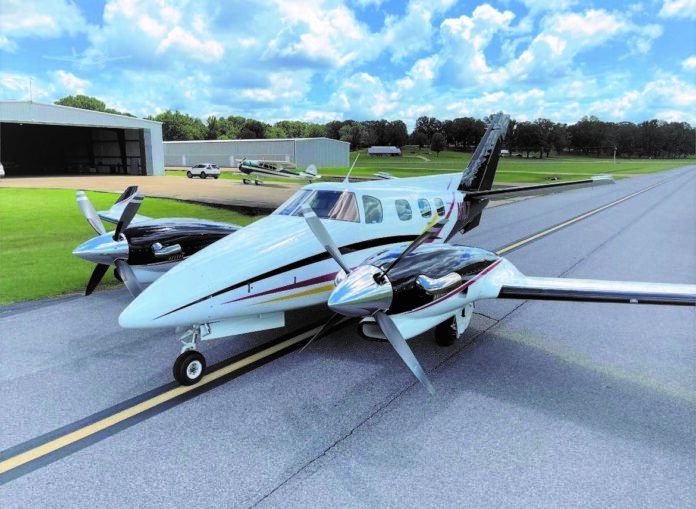It’s simple.
It’s about power.
It’s always about power.
Check out a pilot in a new airplane and after 10 hours the first thing she’ll say is that it’s a good airplane but it needs more power.
Aviation entrepreneurs have long recognized our hunger for a bigger rush when pushing the throttle from quiet to noisy, and have thus provided us with ever more ways to bolt on more horsepower up front. Naturally, after reliable, small turboprop engines debuted in the 1970s those entrepreneurs saw dollar signs and started hanging turboprop engines on piston airframes hoping to capitalize on pilots willing to shell out bucks for performance.
Starting in the late 1970s with a one-off turboprop Bonanza, piston-to-turbine mods began to appear. Due to cost—it turned out that significant airframe mods were often necessary to handle the increased horsepower—what started out as a trickle never became more than a gentle stream. Some mods didn’t cut it and faded away—the Riley turboprop Cessna 421 comes to mind—while others, such as the JetProp conversion of the Piper Malibu/Mirage series and Silver Eagle Cessna P210 mod, were successful and enjoy a devoted following to this day.
Because of the cost of new engines—getting uncomfortably near $1 million—new mods seem to have slowed to a crawl, but existing turboprop mods are very much in use. We’ll start with some background on what’s involved with a turboprop mod, what one can do—and can’t, as useful load and range are limited and can be big-time issues—and then look at a selection of airplanes in the current market.
IT’S POWER VS. WEIGHT
The amazing power to weight ratio of turbine powerplants as compared to piston engines initially made the idea of turboprop conversions of the piston aircraft fleet seem a no-brainer. The reality proved to be far more complex.
Turbines burn jet fuel. Jet fuel weighs 0.8 pounds more per gallon than avgas. Turbine engines have significantly higher fuel burn specifics than piston pounders—for each horsepower applied to the prop, a turbine burns more fuel.
Bottom line: The weight benefits of the lighter turbine engine are offset by the requirement to carry more, and heavier, fuel to get the same range. When you put that package into a piston-engine airplane that fits into a T-hangar with fuel tanks designed for piston-engine fuel specifics, it’s challenging to be able to carry enough fuel for a turboprop mod to make it around the block.
The rule of thumb is that until the airframe gets to the size of a TBM, it’s a challenge to find space to store enough fuel to get enough range to make the airplane economically viable.
To make matters worse, once space is found for a satisfactory quantity of fuel, the leftover useful load almost always turns the airplane into a two-place machine when the tanks are topped. Yeah, it sounds bad, but the reality can be quite good if you don’t need to carry all that much and want to go fast.
AIRFRAME CHANGES
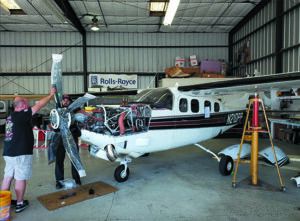
The realities of cost and airframe design dictated that the original manufacturers of piston-engined airplanes designed their airframes to handle the aerodynamic loads, stresses and flutter margins required by the horsepower output of the installed engines plus some, undefined, safety margin.
Those airframes simply weren’t designed to absorb the 30 to 50 percent horsepower increase contemplated by those who itched to install turbine power. That meant the mod shops had to spend extensive time and money on engineering analysis of the existing airframe and come up with the necessary modifications to the structure to beef it up to withstand the additional horsepower as we’ll as the changes in vibratory and harmonic environment and protect it from that scourge of fast airplanes, flutter.
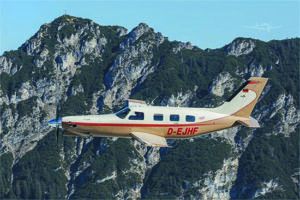
Further, horsepower is destabilizing. That required extensive flight testing to ensure that there is no degradation in stability and control—which can mean modifications to the flight control system.
A final note to be considered for any airplane that has been modified under a Supplemental Type Certificate (STC) as is the case for all turboprop mods: The STC process requires that the applicant demonstrate that the existing capabilities of the airplane, such as stability and control, freedom from flutter and structural integrity, to name a few, have not been degraded.
That’s where the process stops. The STC does not require that the applicant develop and publish new performance data. The STC data that goes with the modified airplane has new aircraft limitations, but almost never has new performance information. That means a buyer is going to have to get informal information on performance from other sources and develop his own data. Accordingly, we recommend that any advertised performance numbers on a turboprop STC (or any STC) be taken with a certain skepticism.
However, the good news is that we’ve found that owners of turboprop conversions have formed various operator groups, are on social media and are willing to exchange information and operating tips.
Our research did uncover an ugly not-so-secret in the turboprop conversion world—some owners ignore operating limitations, especially gross weight, because they seem to think that the extra power gives them a get out of jail free card. That most assuredly isn’t so, as we’ve looked at some accidents that were directly related to overloading and loading outside of CG limits (some mods put fuel in the fuselage, moving the CG aft significantly when fuel is carried in those tanks).
We’ll also point out that part of the turboprop conversion involves moving the redline speed from the top of the yellow arc to the top of the green arc. The yellow arc goes away. That means you can probably hit redline in level flight down low, so you can’t get the full value of the increased horsepower unless you go up high. Plus, down low the engine sucks fuel and available range is miserable. That means going as high as possible, as soon as possible, for as long as possible. That requires training to imbue turbine operating reflexes into a pilot who may have been flying pistons exclusively.
The good news is that a cursory search uncovered a number of training operations that specialize in the turboprop mods.
SUPPORT
Because the airplanes came to be through the STC process, there’s always a question of support. Where original STC holders have folded their tents or gone silent, the support vacuum has been filled by FBOs that specialize in maintaining specific turboprop mods, but the shop you need may be thousands of miles away. Before you buy, make sure that there’s a shop that can work on your airplane and that you can get parts.
INSURANCE AND TRAINING
We’ve dealt with the matter of insurance on turbine step-ups at length, most recently in the August 2023 issue. Bottom line—don’t buy or have the mod done to your airplane until you are certain you can get insurance. The same goes for training.
OK, after considering all of the above, what’s out there for the discerning buyer?
JETPROP
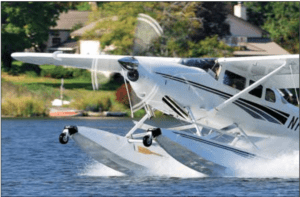
Starting with a non-G1000 Piper Malibu or Mirage, the Rocket Engineering STC used a Pratt & Whitney PT6A-21 engine to create the JetProp DL (550 HP) and a -35 to make the JetProp DLX (560 HP). Some 340 conversions have taken place, making it the most popular of the turboprop mods.
We’ll note that while Rocket Engineering of Spokane, Washington, still holds the STCs for the JetProp, the company is a shell of its former self. We were told by Joe Casey of Casey Aviation (www.flycasey.com), the big dog in the JetProp support world, that Rocket Engineering still provides some parts and support. However, no one answered the phone when we called several times and its website has been taken down. Our research indicated that Casey Aviation in Diboll, Texas, is now the place to go for JetProp support and sales. From what we can tell, Rocket Engineering is currently not doing any conversions.
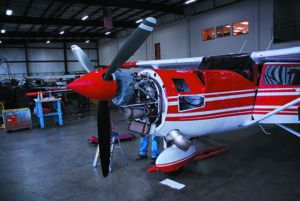
Up front, a four-blade, reversing, full-feathering prop is installed. The 5.3 PSI pressurization system of the Malibu series is retained, giving a 9500-foot cabin at the max operating altitude of FL 270—which, in our opinion, is why the JetProp is the most popular of the turboprop mods.
The fuel system is modified to bring the usable quantity to 151.6 gallons. Gross weight depends on the model year of the Malibu/Mirage that was modified. The fact on loading is that with full fuel you can plan on being able to put 350-400 pounds in the cabin.
Another attraction of the JetProp was that it outperformed Piper’s first cut at a turboprop in the Malibu/Mirage airframe, the Meridian. Even as Piper upped the capabilities of the Meridian, the JetProp remained more efficient because Piper used a larger version of the PT6A and derated it. That meant that a lot more fuel had to be used to spin metal that wasn’t being used to create thrust. As Joe Casey put it, “The JetProp has the biggest of the small-block PT6s while the Meridian has the smallest of the big-block PT6s.”
Casey told us that a JetProp will cruise at 260 KTAS on 32 GPH, while the Meridian will burn 39 GPH to do the same thing.
On the Casey Aviation website there is a performance comparison of the JetProp DL and DLX. Suffice to say that they are very close, with the DLX climbing slightly better and cruising faster while burning more fuel. On a 400-NM trip the time difference is under 10 minutes with the DL burning a few fewer gallons.
Depending on the specific mod, engine time and installed avionics, we saw JetProp prices ranging between $700,000 and $1.7 million.
SILVER EAGLE
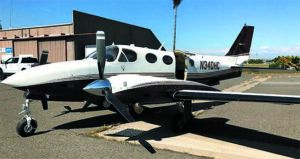
Start with a Cessna P210. Drop in a 198-pound Rolls-Royce 250-B17F/2 turbine engine. Install various airframe beef-ups including new, heavier horizontal and vertical stabilizer mounts, dual elevator trim tabs, air conditioning and new wiring—involving some 3400 hours of labor. The result is the Silver Eagle turboprop conversion, originally developed by O & N Aircraft Modifications, no longer in business.
The 3.35 PSI max differential pressurization of the P210 remains in place, giving a cabin altitude of about 12,000 feet at the max operating altitude of FL 230. We did hear from JetProp owners that they did not buy a Silver Eagle because they weren’t impressed with the max diff pressurization of the 210. And we heard from Silver Eagle owners who said they bought theirs because they were too tall to fit in the rather cramped flight deck of the JetProp.
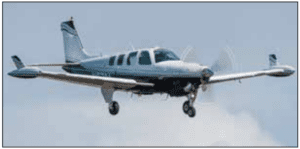
Most of the slightly more than 100 Silver Eagle mods in service have the max fuel offered by the conversion—148 gallons in the standard wing tanks, a 26.8-gallon tank in the baggage compartment and 32.5 gallons in Flint tip tanks. We note that the 210 has the longest CG range of any piston single, but fuel in the back end means paying attention when loading.
And, loading is an issue. Aviation Consumer flew a Silver Eagle back in 2010 and found that with full fuel, cabin load was limited to 310 pounds. Leave the tip tanks empty and the cabin load goes up to 524 pounds. With full fuel, figure on a 45-minute reserve VFR range of 1175 NM, with 5.6 hours endurance at max cruise up in the flight levels.
Our flight saw 190 knots at 17,500 feet—owners report cruise speeds from 190 to 220 KTAS with fuel burns in the mid-20s GPH. The Rolls-Royce engine is a bit more fuel efficient than the PT6.
Owners told us that they consider the Silver Eagle to cruise at about the same speed as a Vitatoe P210 (piston) conversion at altitude, but they get there much faster and consider the turbine engine more reliable. One told us that he spent the extra money for the turbine for its reliability in the rugged country where he regularly flies and for its ease of operation.
Bob Nichols, proprietor of PropJet 210 Aviation (www.propjet210aviation.com) in Santa Rosa, California, worked closely with the creator of the Silver Eagle, O & N, for 13 years and his shop specializes in maintaining and selling the aircraft. He told us that the sweet spot for cruising the Silver Eagle is from 15,000 to FL 210 and noted that as the Rolls-Royce engines are being overhauled, new components are making them more efficient and he’s observing even faster rates of climb and cruise speeds.
The Silver Eagle STCs are now held by Griggs Aircraft (www.griggsaircraft.com) in Tuckhannock, Pennsylvania. Proprietor Matt Griggs worked for O & N for many years, and after O & N ceased operations many of its employees went to work for Griggs. It is now the center for Silver Eagle sales and service for the eastern U.S.
Silver Eagle prices vary with engine and airframe time and installed avionics. We saw a range from $600,000 to $1.5 million.
SOLOY
It is not true that Soloy was doing turboprop conversions in World War I, although it’s been more than 50 years since it started doing them with helicopters. As with other turbine conversion innovators, the original company is gone—the Soloy STCs are now owned by NorthPoint Aviation (www.northpointaviation.net) of Brainerd, Minnesota.
Currently, NorthPoint has the STCs to convert the Cessna 206H, T206H, 207 and Beech A36 Bonanza to turbine power using the Rolls-Royce turboprop engines.
The Cessna conversions have proven popular where avgas is difficult to obtain and, unlike many other turboprop mods, have significant useful load with full fuel—nearly 900 pounds in the 206, and 1335 pounds in the 207— and decent range at non-oxygen altitudes. The Rolls-Royce turboprop is rated at 420 HP in those mods and fuel burn ranges from the high teens to high 20s GPH in cruise.
The Soloy Bonanza mod pulls 450 HP from its installed Rolls-Royce 250-B17F/2 engine, giving it a nearly 2000 FPM initial rate of climb and best cruise just over 200 knots with a VFR range of nearly 1000 NM, although it’s at best a two-place airplane with all 114 gallons of fuel aboard.
NorthPoint does not publish prices for its turbine conversions and did not return our calls for information, although with the price of a new Rolls-Royce engine, we’d be surprised if a conversion cost less than $1 million.
The airplanes change hands only rarely; the few prices we’ve seen have been just north of $1 million.
ROYAL TURBINE
Rocket Engineering converted approximately 20 Beech Dukes to turbine power using two 525-HP PT6A-35 engines, giving a max cruise of as much as 290 knots at FL 270. With full fuel, 658 pounds can be carried in the cabin, with VFR range on the order of 1000 NM and a 3.5-hour endurance.
Casey Aviation, in Diboll, Texas, provides service and support.
SILVER EAGLE II
O & N Aircraft Modifications converted four Cessna 340s to turbine power using 450-HP Rolls-Royce 250-B17F/2 turboprops. They are supported by PropJet 210 Aviation in Santa Rosa, California.
With the tanks topped with 258 gallons of jet fuel, it can carry some 420 pounds in the cabin and fly over 1200 NM at more than 230 KTAS.
CONCLUSION
Cessna’s development of the Caravan seemed to puncture the balloon of hesitation manufacturers had in producing single-engine turboprops. Piper, with its Meridian, in our opinion, slowed the turboprop conversion bandwagon.
While the Meridian had issues with payload and range, Piper steadily improved its capabilities so much that we now consider the turboprop conversions generally to be the Mark I of the single-engine turboprop world and, to our mind, what caused the manufacturers to have the guts to move into the market.
We consider the single-engine turboprop market to be mature and doubt that many piston aircraft owners will pay the freight to convert theirs to turbine power when it would be much cheaper to buy one already converted or a used production machine.
The exception to that statement is for the Soloy Cessna 206 and 207 conversions, although used Daher Kodiaks might be less expensive than the cost of the turboprop conversion.
In our opinion, anyone considering a single-engine turboprop should look carefully at her or his desired mission, especially the number of passengers to be carried, because the cost, efficiency and speed of a Silver Eagle or JetProp might make one of them just the right airplane.

